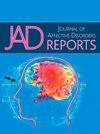鼻内消旋氯胺酮治疗难治性抑郁症:门诊治疗的疗效和耐受性
Q3 Psychology
引用次数: 0
摘要
背景和目的经鼻外消旋氯胺酮是治疗难治性抑郁症(TRD)的一种标签外替代药物,提供了一种非侵入性的选择,与艾氯胺酮相比更便宜。然而,其在门诊的有效性和安全性仍有待进一步研究。本研究旨在评估TRD患者鼻内消旋氯胺酮的安全性、耐受性和有效性。方法回顾性分析45例患者(平均年龄50.7岁,21例女性),这些患者在4周内完成了8次鼻内消旋氯胺酮治疗的诱导期。使用Montgomery-Åsberg抑郁评定量表(MADRS)测量症状严重程度。完全缓解定义为MADRS评分较基线降低≥50%,部分缓解定义为降低25 - 50%。结果外消旋氯胺酮平均剂量为114.0 mg, 4周后平均MADRS评分降低34.5%。血压平均增加7.4 mmHg收缩压和6.9 mmHg舒张压。配对t检验比较基线和第8周MADRS评分,结果显示得分有统计学意义的降低,平均差值为10.04。MADRS降低的Cohen的d值为1.30,表明效果很大。31.1%的患者达到完全缓解,33.3%的患者达到部分缓解。欣快感是治疗反应的显著预测因子(p <;0.001)。4例患者发生了需要医疗干预的不良事件,不良反应导致的退出率为4.2%。结论经鼻外消旋氯胺酮治疗TRD疗效好,耐受性好,安全性好,抗抑郁效果显著。本文章由计算机程序翻译,如有差异,请以英文原文为准。
Intranasal racemic ketamine in treatment-resistant depression: Efficacy and tolerability in outpatient treatment
Background and aim
Intranasal racemic ketamine is an off-label alternative for treatment-resistant depression (TRD), offering a non-invasive and compared to esketamine less expensive option. However, its efficacy and safety in outpatient settings remain underexplored. This study aimed to assess the safety, tolerability, and efficacy of intranasal racemic ketamine in patients with TRD.
Methods
This retrospective analysis included 45 patients (mean age 50.7 years, 21 women) who completed an induction phase of eight treatments with intranasal racemic ketamine over four weeks. Symptom severity was measured using the Montgomery-Åsberg Depression Rating Scale (MADRS). A complete response was defined as a ≥ 50 % reduction in MADRS scores from baseline, and a partial response as a 25–50 % reduction.
Results
The mean racemic ketamine dose was 114.0 mg, the mean MADRS score reduction after four weeks was 34.5 %. The mean increase in blood pressure was 7.4 mmHg systolic and 6.9 mmHg diastolic. A paired t-test comparing baseline and week 8 MADRS scores revealed a statistically significant reduction in scores, with a mean difference of 10.04. Cohen’s d for MADRS reduction was 1.30, indicating a large effect. A total of 31.1 % of patients achieved a complete response, and 33.3 % had a partial response. Euphoria was a significant predictor of treatment response (p < 0.001). Adverse events requiring medical intervention occurred in four patients, and the drop-out rate due to adverse effects was 4.2 %.
Conclusions
Intranasal racemic ketamine is an effective, well-tolerated treatment for TRD, with favorable safety outcomes and substantial antidepressant effects.
求助全文
通过发布文献求助,成功后即可免费获取论文全文。
去求助
来源期刊

Journal of Affective Disorders Reports
Psychology-Clinical Psychology
CiteScore
3.80
自引率
0.00%
发文量
137
审稿时长
134 days
 求助内容:
求助内容: 应助结果提醒方式:
应助结果提醒方式:


